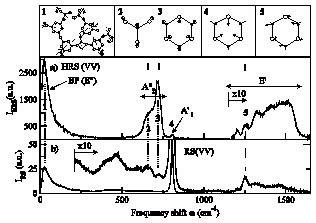Rechercher
Accueil > La Recherche > Axes & Equipes > Matière Molle & Verres > Equipe : Physique des Verres > Thème : Structure, vibration, relaxations dans les systèmes désordonnés
Hyper-Raman scattering analysis of the vibrations in borate glasses
publié le , mis à jour le
Involved researchers : B. Hehlen, G. Simon, E. Courtens, R. Vacher
Hyper-Raman scattering has been measured on vitreous boron oxide, v-B2O3. This spectroscopy, complemented with Raman scattering and infrared absorption, reveals the full set of vibrations that can be observed with light. A mode analysis is performed based on the local D3h symmetry of BO3 triangles and B3O3 boroxol rings. The results show that in v-B2O3 the main spectral components can be successfully assigned using this relatively simple model (cf. figure).

In particular, it can be shown that the hyper-Raman boson peak arises from external modes that correspond mainly to librational motions of rigid triangles and rings coupled to their translations (G. Simon et al. PRL 2007).
In lithium borate glasses, 4B2O3:Li2O and 2B2O3:Li2O, we observe a mode associated with stretching motions of BO4 units can be assigned to a vibration of F2-symmetry in the Td tetrahedral point group. The hyper-Raman scattering intensity of its transverse optic component appears to be proportional to the number of BO4 units in the glass.








